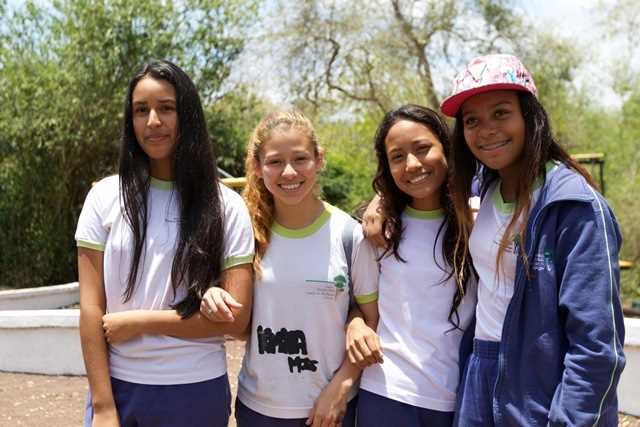Oh what does it mean to wake up on the waters of the Galapagos Islands! As a Grosvenor Teacher Fellow on board the National Geographic Endeavour, it means unimaginable possibilities and experiences waiting to happen: the undrawn forms on the white space of a blank sheet of paper, the beginning of a thought before it takes to full fruition, and the pause between each inhalation and exhalation as a continuation of life. It means honing in on all those senses so every moment is captured in either the muscular memory or the imagination. It means all that education waiting to happen!
I woke up to a full view of the charming Santa Cruz Island alongside small and medium-sized ships anchored near the coastline of Puerto Ayora, the economic capital of Santa Cruz Island. The island, boasting of the largest human settlement of these remote Islands, was in full swing with the usual hustle and bustle of life.
The city of Puerto Ayora is surrounded by untraceable shades of shimmering blues and greens--azure, turquoise, and emerald to a deep, deep, midnight navy. Parts of the dock are painted in electric blue, slowly fading into the incessant lapping of seawater. The streets are lined with charming houses of various sizes, some adorned by vibrant hibiscus blossoms. The hibiscus is an introduced species, not endemic to the islands. Women clad in Wellingtons and aprons work the fish market, sometimes pausing to feed a seemingly tame sea lion and flock of pelicans begging for fish morsels. I watched a little boy, barely out of his toddler years, playing with the pelicans, both unafraid of the other. It is a picture of coexistence between humans and animals. A mutual respect developed over time through education, conservation effort, and fifty years of deliberate actions of preserving the delicate balance between human and natural interactions.
We walked to the iconic Charles Darwin Station headquarters where we witnessed one of the most successful conservation projects run by the Galapagos National Park Service—the captive breeding and posterior release program of the giant tortoises of the Galapagos. I cannot express in mere words the awe I experienced at the power of human capacity to destroy, or to preserve. That the tortoises were slaughtered to the brink of extinction in the 19th and early 20th century from a population of 200,000 to a mere 2000 is a devastating glimpse of that destructive power. However, the Darwin Center’s combined effort with scientists, naturalists, rangers, and Ecuadorian and international initiatives manage to instill hope at man’s ability to recognize and counter such catastrophe. At the Center, we saw the two types of giant tortoises, the saddleback and the dome-shaped. The Galapagos, which means saddleback, is the namesake of the archipelago of the Galapagos.
Interestingly, the saddleback tortoiseshell is an example of the evolutionary adaptation of the tortoise that lives in more arid lands than its dome-shaped cousin. The saddle-like arch of the shell allows the tortoise to extend its neck to reach and feed on foliage higher up on a plant. The dome-shelled tortoise on the other hand, lives on the moisture –rich highlands where ground –grazing is plentiful. We also met the tortoise stud, Diego (especially imported from Santiago Zoo) credited with contributing to the rise in sexual activity among the tortoises, and it consequent increase in population. At the time we espied him, Diego looked physically exhausted, legs and neck splayed out, and taking a break from any kind of action.
We retraced our steps from Diego and his surroundings to meet up at Le Roc for our next stop. Tomas de Berlanga, a private preK-12 school, is sponsored by Lindblad Expeditions. Lindblad Expeditions pays tuition for 30-40% of students attending the school. The goal of the sponsorship is “to educate the leaders of tomorrow.” At the school, Matt Geiger the Principal gave us a brief but interesting introduction to the academic program. Matt spoke about the teacher leadership and collaboration initiative the school had undertaken as well as a student leadership program based on “The Seven Habits of Man” by S. Covey. He also mentioned that the reading curriculum followed the Common Core Standards implemented in the USA. Catharine, a cheerful high school student, gave us a tour of the campus where all classrooms had open, well-ventilated rooms with no glass panes. When asked about her opinion on the curriculum, Catherine mentioned that Common Core forced students to think and analyze text that was difficult. She loved it.
After lunch, buses transported us to a timber and cattle farm up in the highlands where dome-shelled tortoises roam free. We changed into Wellington boots and set off in search of enormous antediluvian creatures in their natural habitat. We spied juveniles and adults easily reaching an astonishing weight of 400 pounds. These zen-like creatures with a perpetual half-smile on their face grazed peacefully among cattle, inched through muddy ponds, and ambled through bushy undergrowth with half-chomped leaves trailing out of their mouths. Again, I was reminded of the intense, yet fragile interconnection between man and beast.
At sunset we climbed into the Zodiac and rode the rolling swells of the Galapagonian waters to the National Geographic Endeavour. As a fellow passenger observed, it took the skills of a rodeo champ to navigate our legs over the bouncing Zodiac on to the steps of the ship.
The night ended with a fabulous dinner on the ship with five passionate public school teachers from the island and live music by a local Galapagonian band, accompanied by dancing damsels dressed in hand-painted, flaring skirts. I watched the swirls of color, undulating bodies, and enthralled guests moving to the catchy beat of the music, and fervently prayed that I may successfully transfer my amazing experiences to my students who will one day inherit the earth.







